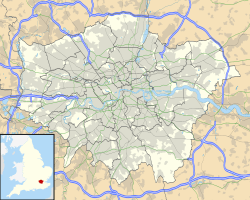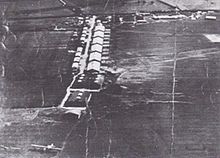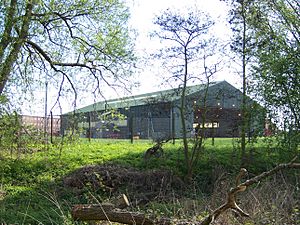RAF Northolt facts for kids
Quick facts for kids RAF Northolt
|
|||||||
|---|---|---|---|---|---|---|---|
| Ruislip, Greater London in England | |||||||
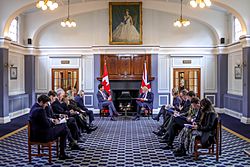
Prime Minister Boris Johnson holding a bilateral summit with the Prime Minister of Canada, Justin Trudeau, inside the RAF Northolt Officers' Mess, 7 March 2022
|
|||||||

Latin: Aut portare aut pugnare prompti
("Ready to carry or to fight") |
|||||||
|
Shown within Greater London
|
|||||||
| Coordinates | 51°33′11″N 000°25′06″W / 51.55306°N 0.41833°W | ||||||
| Type | Royal Air Force station | ||||||
| Site information | |||||||
| Owner | Ministry of Defence | ||||||
| Operator | Royal Air Force | ||||||
| Controlled by | No. 2 Group (Air Combat Support) | ||||||
| Site history | |||||||
| Built | 1915 | ||||||
| In use | 1915–present | ||||||
| Garrison information | |||||||
| Occupants |
|
||||||
| Airfield information | |||||||
| Identifiers | IATA: NHT, ICAO: EGWU, WMO: 03672 | ||||||
| Elevation | 124 ft (38 m) AMSL | ||||||
|
|||||||
Royal Air Force Northolt, or RAF Northolt, is a special air base for the Royal Air Force (RAF). It is located in South Ruislip, in western Greater London, England. This base is about 6 miles (10 km) north of Heathrow Airport. RAF Northolt is used for both military flights and important government and VIP (Very Important Person) transport.
Northolt opened in May 1915, making it the oldest RAF base still in use. It was first built for the Royal Flying Corps, which was the air force before the RAF. Before World War II, it was the first base to get the Hawker Hurricane aircraft. RAF Northolt played a very important role during the Battle of Britain. Fighter planes from this base, including the brave No. 303 Polish Fighter Squadron, helped defend London from enemy aircraft. It was also the first base where Supermarine Spitfire planes flew into German airspace.
After World War II, Northolt was used for regular passenger flights while Heathrow Airport was being built. For a time, it was the busiest airport in Europe! Today, it is the main hub for British military flights in the London area. The base has been updated a lot since 2006. It is now home to the British Forces Post Office and several important RAF units. These include No. 32 (The Royal) Squadron, the King's Colour Squadron, and the Central Band of the Royal Air Force.
Contents
RAF Northolt: A Historic Airfield
How it Started
After the first flight across the English Channel in 1909, the British Army realized they needed to protect the country from air attacks. In 1912, there was a plan to build an airfield called "Harrow Aerodrome" near where RAF Northolt is now. However, this plan did not go ahead.
When World War I began, the Royal Flying Corps needed a new airfield. In 1914, they chose a site near Northolt Junction railway station. The government took over the land in January 1915.
Construction of the new airfield, first called "RFC Military School, Ruislip," began in January 1915. It opened on May 3, 1915. It became known as Northolt because of the nearby railway station. In the same year, the airfield was made bigger. Aircraft from Northolt began flying missions to defend London from German Zeppelin airships.
In 1916, No. 43 Squadron RAF was formed at Northolt. They flew planes like the Sopwith 1½ Strutter. This plane was even tested at Northolt by famous pilot Harry Hawker. From 1917 to 1928, the Fairey Aviation company also tested their planes here.
In 1925, No. 600 Squadron RAF and No. 601 Squadron RAF of the new Royal Auxiliary Air Force were formed at Northolt. The Prince of Wales, who later became King Edward VIII, made his first flight from Northolt in 1929.
World War II Heroics
Northolt became a very important base during World War II. It was used by both the Royal Air Force and Polish Air Force squadrons. They defended the United Kingdom from enemy attacks. Northolt was the first RAF station to use the Hawker Hurricane fighter plane. No. 111 Squadron RAF received the first four Hurricanes in December 1937. By 1939, Northolt had a new concrete runway.
During the Battle of Britain on September 15, 1940, several squadrons were based at Northolt. These included No. 1 Squadron RCAF (from Canada), No. 229 Squadron RAF, No. 303 Polish Fighter Squadron, and No. 504 Squadron RAF. All of them flew Hawker Hurricanes. The Polish Squadron shot down the most enemy aircraft during the Battle of Britain. Their Czech pilot, Sergeant Josef František, achieved the most "kills."
The German air force, the Luftwaffe, bombed the airfield in August 1940. However, only two bombs actually hit the airfield itself. The station commander, Group Captain Stanley Vincent, had a clever idea. He camouflaged the airfield to look like regular houses and gardens. This made it very hard for enemy pilots to find.

Thirty Allied airmen from different countries, including Poland, Canada, and New Zealand, died flying from RAF Northolt during the Battle of Britain. The Polish War Memorial stands near the airfield. It honors all Polish airmen who lost their lives in World War II.
Squadrons at RAF Northolt shot down 148 German aircraft during the battle. Group Captain Vincent even shot down a German plane himself, even though he was too old for regular combat flying.
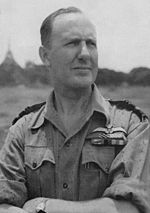
After the Battle of Britain, Northolt continued to be a base for fighter planes. Polish Fighter Squadrons from Northolt took part in Operation Jubilee in 1942. This was a raid on Dieppe, France. In 1943, Northolt became the first base to fly Supermarine Spitfires into German airspace to support bomber planes.
RAF Northolt also became home to Prime Minister Winston Churchill's personal aircraft in June 1944. He used this plane to fly to meetings with other Allied leaders. In November 1944, an Avro York plane flew non-stop from Northolt to Cairo in just over 10 hours.
Post-War and Modern Use
From 1946, Northolt was used for civilian flights while Heathrow Airport was being built. It became a major base for British European Airways (BEA). Other airlines also used it for flights across Europe. In 1952, Northolt was the busiest airport in Europe, with 50,000 aircraft movements.
In December 1946, a plane flying from Northolt to Glasgow crashed onto a house roof in South Ruislip during a snowstorm. Luckily, everyone on board and in the house was safe! The house was later named "Dakota Rest."
Civilian flights stopped in 1954 when Heathrow Airport's main area opened. Northolt then returned to being a military-only base. In 1960, a plane crashed on a dairy plant near Northolt after engine failure, but no one died. Later that year, a Pan Am Boeing 707 mistakenly landed at Northolt instead of Heathrow. To prevent this, large letters "NO" (for Northolt) and "LH" (for Heathrow) were painted on gas towers near each airfield.
By the 1980s, private jets used Northolt more than military aircraft. Civilian flights were limited to 28 per day.
Northolt received its first display plane, a Spitfire, in 1963. This plane was later used in the film Battle of Britain. A new Spitfire was put on display in 1970.
In August 1996, a Spanish Learjet overshot the runway and hit a van on the nearby A40 road. Everyone involved had minor injuries. After this, safety measures were improved, including new safety pits at the end of the runway.
In 1997, the body of Diana, Princess of Wales, arrived at Northolt from Paris. This was a very sad and important event.
Since 1998, the station commanders at Northolt have served as special assistants to the Queen. In 2000, RAF Northolt received the "Freedom of Entry" to the London Borough of Hillingdon. This honor allows military personnel to march through the borough in full uniform.
In 2008, parts of a Hawker Hurricane flown by Flying Officer Ludwik Witold Paszkiewicz were given to the station. He was a Polish pilot from No. 303 Polish Fighter Squadron who shot down many enemy planes during the Battle of Britain.
A new memorial was unveiled in September 2010 to honor British, Polish, Australian, and New Zealand aircrew who died during the Battle of Britain. Some of Northolt's historic buildings, like the Operations Block, were given special protected status. The Operations Block was important because it used the "Dowding System" to direct fighter planes during the Battle of Britain. RAF Northolt is the only airfield used in the Battle of Britain that is still operated by the RAF.
In 2012, four Eurofighter Typhoon aircraft arrived at Northolt for a security exercise for the 2012 Summer Olympics. This was the first time fighter aircraft had been based at Northolt since World War II. They helped protect London during the Games.
The London Air Ambulance also moved its overnight base to RAF Northolt in 2013. This helps them reach emergencies faster. In April 2013, the Ministry of Defence suggested increasing private flights to help the airfield earn more money.
On September 13, 2022, Queen Elizabeth II's coffin arrived at Northolt from Edinburgh Airport. It was then taken to Buckingham Palace. The Prime Minister and other important people were there to meet the flight.
Project MoDEL Redevelopment
The Ministry of Defence started Project MoDEL in 2006. This project aimed to bring many of its London operations to RAF Northolt. Several other RAF bases in London were closed, and their units moved to Northolt. Because of this, Northolt was greatly redeveloped with new buildings and facilities.
A statue of a World War I soldier reading a letter was moved to Northolt in 2007. New buildings were constructed for the British Forces Post Office. New hangars were also built for No. 32 (The Royal) Squadron. The original Officers' Mess building was also updated. A new replica Hawker Hurricane plane was put on display near the eastern entrance in 2010. This honors the aircrew who fought in the Battle of Britain.
When RAF Uxbridge closed, control of the Battle of Britain Bunker passed to RAF Northolt. This allows people to continue visiting it.
Runway Resurfacing
In 2018, a £23 million project began to resurface Northolt's runway. The runway closed on April 15, 2019, for this work. No. 32 (The Royal) Squadron moved its planes to another base, and civilian aircraft used other airports. Helicopters continued to fly from Northolt during the work. The new runway officially reopened on November 1, 2019.
What Happens at RAF Northolt Today
RAF Northolt has different groups that work together. These include flying units and other important support units.
Royal Air Force Units
- No. 1 Group (Air Combat)
- No. 600 (City of London) Squadron (Royal Auxiliary Air Force)
- No. 2 Group (Air Combat Support)
- Air Mobility Force
- No. 32 (The Royal) Squadron – They fly special planes called Envoy IV CC1 and helicopters called AW109SP GrandNew.
- Combat and Readiness Force
- No. 2 Force Protection Wing
- No. 63 Squadron (King's Colour Squadron) RAF Regiment
- No. 2 Force Protection Wing
- RAF Music Services
- Headquarters RAF Music Services
- Central Band of the RAF
- Band of the Royal Air Force Regiment
- Air Mobility Force
- Other Units
- No. 601 (County of London) Squadron (Royal Auxiliary Air Force)
- RAF Centre for Air Power Studies
- Air Historical Branch
British Army Units
- Royal Logistic Corps
- 29 Explosive Ordnance Disposal and Search Group
- 11 Explosive Ordnance Disposal and Search Regiment
- 621 Explosive Ordnance Disposal Squadron (They handle bombs and dangerous items.)
- 11 Explosive Ordnance Disposal and Search Regiment
- 29 Explosive Ordnance Disposal and Search Group
Strategic Command Units
- Defence Intelligence
- Director of Cyber Intelligence and Information Integration
- Joint Forces Intelligence Group (JFIG)
- No. 1 Aeronautical Information Documents Unit (AIDU) (They provide important flight information.)
- Joint Forces Intelligence Group (JFIG)
- Director of Cyber Intelligence and Information Integration
Defence Equipment and Support Units
- British Forces Post Office (They handle mail for the armed forces.)
Ministry of Defence Units
- Service Prosecution Authority (They deal with legal matters for military personnel.)
Squadrons and Aircraft
Many different squadrons and aircraft have been based at RAF Northolt throughout its long history. Here are some of them:
| Unit | Dates | Aircraft | Notes |
|---|---|---|---|
| No. 1 Squadron RAF | August–September 1940 | Hawker Hurricane I | |
| No. 1 Squadron RCAF | August–October 1940 | Hawker Hurricane I | From Canada |
| No. 16 Squadron RAF | April–September 1944 | Supermarine Spitfire XI | Moved to France |
| No. 18 Squadron RFC | May–August 1915 | Various | Formed at Northolt |
| No. 24 Squadron RAF | January 1927 – February 1933 | Variety of types | Used for communications |
| No. 32 Squadron RAF | February 1969 – Present | Percival Pembroke, Bristol Sycamore, BAe 146, AgustaWestland AW109, Dassault Falcon 900LX | Used for communications and transport |
| No. 41 Squadron RAF | April 1923 – October 1935 | Sopwith Snipe, Bristol Bulldog, Hawker Demon | |
| No. 43 Squadron RAF | May–September 1940 | Hawker Hurricane I | Operated detachments from another base |
| No. 65 Squadron RAF | October 1939 – March 1940 | Supermarine Spitfire I | |
| No. 111 Squadron RAF | July 1934 – October 1939 | Bristol Bulldog, Gloster Gauntlet, Hawker Hurricane | |
| No. 140 Squadron RAF | April–September 1944 | De Havilland Mosquito IX and XVI | Moved to France |
| No. 229 Squadron RAF | September–December 1940 | Hawker Hurricane I | |
| No. 302 Polish Fighter Squadron | October–November 1940, December 1943 – March 1944 | Hawker Hurricane I | Polish unit |
| No. 303 Polish Fighter Squadron | January–July 1941 | Supermarine Spitfire I, IIA and IIB | Famous Polish unit |
| No. 306 Polish Fighter Squadron | April–October 1941, June 1942 – March 1943 | Hawker Hurricane, Supermarine Spitfire VB then IX | Polish unit |
| No. 308 Polish Fighter Squadron | October–December 1943 | Supermarine Spitfire IIA | Polish unit |
| No. 315 Polish Fighter Squadron | July 1941 – April 1942 | Supermarine Spitfire IIA, IIB and VB | Polish unit |
| No. 316 Polish Fighter Squadron | December–April 1942, March–September 1943 | Supermarine Spitfire VB | Polish unit |
| No. 317 Polish Fighter Squadron | April–June 1942, July–September 1942, September–December 1943 | Supermarine Spitfire VB then IX | Polish unit |
| No. 600 Squadron RAF | October 1925 – January 1927, August–October 1939, May–June 1940 | De Havilland DH.9A, Bristol Blenheim I | Formed at Northolt |
| No. 601 Squadron RAF | October 1925 – January 1927, December 1940 – May 1941 | De Havilland DH.9A, Hawker Hurricane I, II | Formed at Northolt |
| No. 609 Squadron RAF | May–July 1940 | Supermarine Spitfire I | |
| No. 615 Squadron RAF | October–December 1940 | Hawker Hurricane I |
See also
- List of Battle of Britain airfields
- List of Royal Air Force stations


